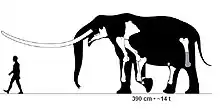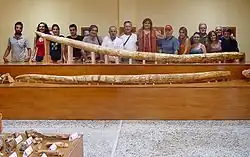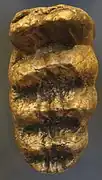| "Mammut" borsoni Temporal range: | |
|---|---|
 | |
| Size comparison of a specimen from Milia, Greece compared to a human | |
| Scientific classification | |
| Kingdom: | |
| Phylum: | |
| Class: | |
| Order: | |
| Family: | |
| Genus: | †"Mammut" |
| Species: | †"M." borsoni |
| Binomial name | |
| †"Mammut" borsoni (Hays, 1834) | |
"Mammut" borsoni is an extinct species of mammutid proboscidean known from the Late Miocene to Early Pleistocene of Eurasia, spanning from western Europe to China. It is the last known mammutid in Eurasia, and amongst the largest of all proboscideans.
Taxonomy
"Mammut" borsoni was first described by American naturalist Isaac Hays in 1834 as Mastodon borsoni, for a tooth discovered near Villanova d'Asti in Piedmont, Italy. It was named after professor Stefano Borson, who had originally attributed the tooth to the species Mastodon giganteum.[1] Since its description it has been attributed to both the genera Zygolophodon and Mammut. The attribution of "M". borsoni to Mammut has been considered questionable, as the type species for Mammut is known from North America, and there is no evidence there was a migration of Mammut from Eurasia to North America or vice versa, with the similarities between North American Mammut and "M." borsoni being potentially due to separate parallel evolution from Zygolophodon in Eurasia and North America. Due to the uncertainty, the species continues to be provisionally named "Mammut" borsoni.[2] Some authors choose to segregate some late Miocene fossils into the species “Mammut” obliquelophus which has molars essentially identical to Pliocene "Mammut" borsoni but the mandibular symphysis of the jaw is somewhat more elongate with larger lower tusks, and the upper tusks are probably shorter.[3]
Description
"Mammut" borsoni is one of the largest proboscideans known. A 2015 study estimated that some not fully grown specimens from Milia in Greece weighed about 14 tonnes (15.4 short tons) with a shoulder height of 3.9 metres (12.8 ft), with one specimen from the same locality known from an isolated femur estimated to weigh 16 tonnes (17.6 short tons) with a shoulder height of 4.1 metres (13.5 ft); the latter is also estimated to have had been the average size of males of the species. Both of these weight estimates are considerably larger than any known modern elephant, and place it as amongst the largest land mammals to have ever lived.[4] The upper tusks lack enamel bands,[3] are straight to slightly upwardly curved,[2] and the longest known amongst proboscideans, with one preserved tusk from Milia measuring 5.02 metres (16.5 ft) in length,[5][4] with an estimated mass of around 137 kilograms (302 lb).[6] In comparison to earlier mammutids like Zygolophodon, the lower jaw (particularly the mandibular symphysis) is relatively short, but still bears small lower tusks.[7][2] The jaws appear to have lacked permanent premolar teeth, which are present in more primitive mammutids.[8]
 Tusks of "M." borsoni from Milia, Greece, which are the longest tusks ever found
Tusks of "M." borsoni from Milia, Greece, which are the longest tusks ever found Molar tooth
Molar tooth Lower jaw
Lower jaw
Ecology
Dental microwear and mesowear analysis of specimens from the Pliocene of Romania and England, respectively, suggest that "M". borsoni was primarily a browser.[9][10]
Distribution and chronology
"Mammut" borsoni is known from localities across Europe, spanning from the Iberian Peninsula in the west to Ukraine and Greece in the east.[2] Remains have also been reported from China.[11] Some authors have suggested that the species derived from Zygolophodon turicensis.[7] The oldest specimens date to the late Miocene, while the youngest date to the earliest Pleistocene, around 2-2.5 million years ago.[2]
References
- ↑ Hays, Isaac (1834). "Descriptions of the Specimens of Inferior Maxillary Bones of Mastodons in the Cabinet of the American Philosophical Society, with Remarks on the Genus Tetracaulodon (Godman), &c". Transactions of the American Philosophical Society. 4: 317–339. doi:10.2307/1004835. JSTOR 1004835.
- 1 2 3 4 5 Koenigswald, Wighart; Březina, Jakub; Werneburg, Ralf; Göhlich, Ursula (2022). "A partial skeleton of "Mammut" borsoni (Proboscidea, Mammalia) from the Pliocene of Kaltensundheim (Germany)". Palaeontologia Electronica. doi:10.26879/1188. S2CID 247374131.
- 1 2 Yaghoubi, Sadaf; Ashouri, Ali Reza; Ataabadi, Majid Mirzaie; Ghaderi, Abbas (2023-07-05). First true mastodon from the Late Miocene of Western Asia (Report). In Review. doi:10.21203/rs.3.rs-3046011/v1.
- 1 2 Larramendi, A. (2016). "Shoulder height, body mass and shape of proboscideans" (PDF). Acta Palaeontologica Polonica. 61. doi:10.4202/app.00136.2014.
- ↑ Mol, D. and van Logchem, W. 2009. The mastodon of Milia: the longest tusks in the world. Deposits 19: 28–32.
- ↑ Larramendi, Asier (2023-12-10). "Estimating tusk masses in proboscideans: a comprehensive analysis and predictive model". Historical Biology: 1–14. doi:10.1080/08912963.2023.2286272. ISSN 0891-2963.
- 1 2 Mazo, A.V.; Van der Made, J. (March 2012). "Iberian mastodonts: Geographic and stratigraphic distribution". Quaternary International. 255: 239–256. doi:10.1016/j.quaint.2011.07.047.
- ↑ Sanders, William J. (2018-02-17). "Horizontal tooth displacement and premolar occurrence in elephants and other elephantiform proboscideans". Historical Biology. 30 (1–2): 137–156. doi:10.1080/08912963.2017.1297436. ISSN 0891-2963.
- ↑ Haiduc, Bogdan S.; Răţoi, Bogdan G.; Semprebon, Gina M. (February 2018). "Dietary reconstruction of Plio-Pleistocene proboscideans from the Carpathian Basin of Romania using enamel microwear". Quaternary International. 467: 222–229. doi:10.1016/j.quaint.2018.01.039.
- ↑ Saarinen, Juha; Lister, Adrian M. (October 2016). "Dental mesowear reflects local vegetation and niche separation in Pleistocene proboscideans from Britain: DENTAL MESOWEAR IN PLEISTOCENE PROBOSCIDEANS". Journal of Quaternary Science. 31 (7): 799–808. doi:10.1002/jqs.2906.
- ↑ Zhang, Xiaoxiao; Wang, Shiqi (2021-09-02). "First report of Eozygodon (Mammutidae, Proboscidea) in Eurasia". Historical Biology. 33 (9): 1661–1670. doi:10.1080/08912963.2020.1723579. ISSN 0891-2963. S2CID 213467027.